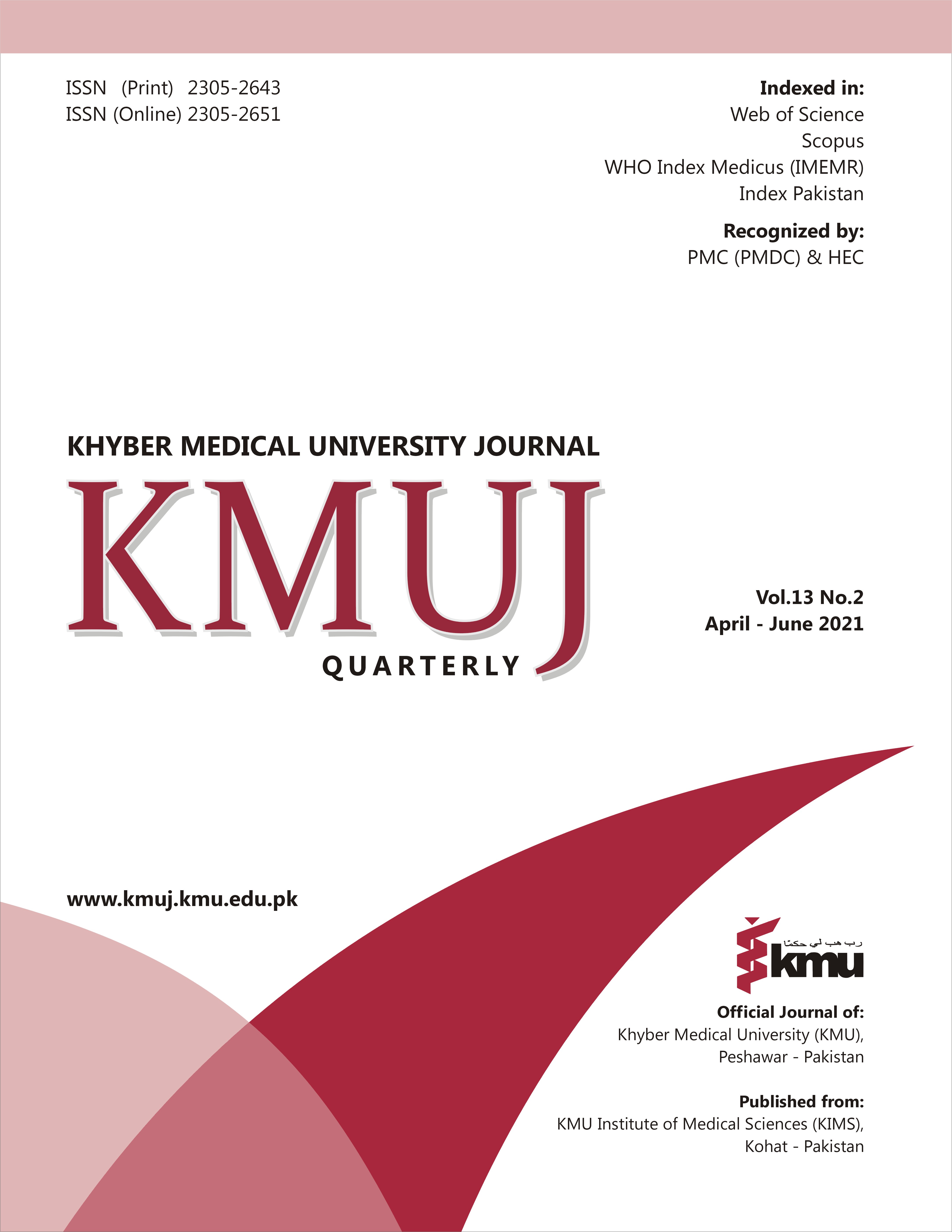ASSOCIATION OF DYSLIPIDEMIA WITH ANXIETY AND DEPRESSION IN PATIENTS OF POLYCYSTIC OVARIAN SYNDROME
Main Article Content
Abstract
OBJECTIVE: To find-out the association of dyslipidemia with anxiety and depression in patients with polycystic ovarian syndrome (PCOS).
METHODS: This descriptive cross-sectional study was conducted at Mardan Medical Complex, Mardan, Pakistan from December-2019 to March-2020. One hundred & forty diagnosed cases of PCOS, ranging in age from 20-40 years, were selected through purposive sampling. Anxiety and depression were calculated using hospital anxiety and depression scale (HADS) score. Total cholesterol (TC), triglycerides, low-density-lipoproteins (LDL), high-density-lipoproteins (HDL) and testosterone were tested through fasting blood samples.
RESULTS: Anxiety and depression were documented in 102 (72.9%) & 99 (70.7%) cases respectively. Primary infertility, oligomenorrhoea, Hirsutism & acne were present in 69 (49.3%), 111 (73.5%), 81 (57.9%) and 55 (39.3%) patients respectively. Twenty-two (15.7%) patients were overweight/obese. All patients had raised testosterone levels and polycystic ovaries on ultrasound. Raised triglyceride levels (≥150 mg/dl), Low levels of HDL (≤ 60mg/dl), raised levels of LDL (≥130 mg/dl), raised cholesterol levels (≥200 mg/dl) were reported in 71/99 (71.7%), 56/99 (56.6%), 38/99 (38.4%) & 10/99 (10.2%) cases with depression as compared to 27/41 (65.9%), 13/41 (31.7%), 21/41 (51.2%) & 14/41(34.1%) non-depressed patients respectively. Similarly raised triglyceride levels, low levels of HDL, raised levels of LDL, raised cholesterol levels were reported in 73/102 (71.6%), 58/102 (56.9%), 40/102 (39.2%) & 12/102 (11.76%) cases with anxiety as compared to 25/38 (65.8%), 11/38 (28.9%), 19/38 (50%) and 12/38 (31.6%) patients without anxiety respectively.
CONCLUSION: Dyslipidemia, anxiety and depression are very common in PCOS. Dyslipidemia is associated with anxiety and depression in PCOS patients.
Article Details
Work published in KMUJ is licensed under a
Creative Commons Attribution 4.0 License
Authors are permitted and encouraged to post their work online (e.g., in institutional repositories or on their website) prior to and during the submission process, as it can lead to productive exchanges, as well as earlier and greater citation of published work.
(e.g., in institutional repositories or on their website) prior to and during the submission process, as it can lead to productive exchanges, as well as earlier and greater citation of published work.
References
Sulaiman MA, Al-Farsi YM, Al-Khaduri MM, Waly MI, Saleh J, Al-Adawi. Psychological burden among women with polycystic ovarian syndrome in Oman: a case-control study. Int J Womens Health 2017;9:897-904. https://doi.org/10.2147/IJWH.S145383.
Karjula S, Morin-Papunen L, Franks S, Auvinen J, Jarvelin MR, Tapanainen JS, et al. Population-based data at ages 31 and 46 show decreased HRQoL and life satisfaction in women with PCOS symptoms. J Clin Endocrinol Metab 2020; 105(6):1814-26. https://doi.org/10.1210/clinem/dgz256
Cinar N, Kizilarslanoglu MC, Harmanci A, Aksoy DY, Bozdag G, Demir B, et al. Depression, anxiety and cardiometabolic risk in polycystic ovary syndrome. Hum Reprod 2011;26(12):3339-45. https://doi.org/10.1093/humrep/der338
Palomba S, Santagni S, Falbo A, La Sala GB. Complications and challenges associated with polycystic ovary syndrome: current perspectives. Int J Womens Health 2015;7:745-63. https://doi.org/10.2147/IJWH.S70314
Azziz R. Diagnosis of Polycystic Ovarian Syndrome: The Rotterdam Criteria Are Premature. J Clin Endocrinol Metab 2006;91(3):781-5. https://doi.org/10.1210/jc.2005-2153
Nuttall FQ. Body Mass Index: Obesity, BMI, and Health: A Critical Review. Nutr Today 2015;50(3):117-28. https://doi.org/10.1097/NT.0000000000000092
Bocéréan C, Dupret E. A validation of the Hospital Anxiety and Depression Scale (HADS) in a large sample of french employees. BMC Psychiatry 2014;14:354. https://doi.org/10.1186/s12888-014-0354-0
Mumford DB, Tareen IA, Bajwa MA, Bhatti MR, Karim R. The translation and evaluation of an Urdu version of the Hospital Anxiety and Depression Scale. Acta Psychiatr Scand 1991;83(2):81-5. http://dx.doi.org/10.1111/j.1600-0447.1991.tb07370.x
Knopfholz J, Disserol CC, Pierin AJ, Schirr FL, Streisky L. Validation of the friedewald formula in patients with metabolic syndrome. Cholesterol 2014;2014:261878. http://dx.doi.org/10.1155/2014/261878
Sane R, Amin G, Dongre S, Mandole R. Evaluation of the lipid parameters in chronic heart failure patients and their correlation with body mass index. Int J Adv Med 2019;6(3):805-9. http://dx.doi.org/10.18203/2349-3933.ijam20192243
Luppa P, Brückner C, Schwab I, Hauck S, Schmidmayr S, Birkmayer C, et al. 7α-Biotinylated testosterone derivatives as tracers for a competitive chemiluminescence immunoassay of testosterone in serum. Clin Chem 1997;43(12):2345-52. https://doi.org/10.1093/clinchem/43.12.2345
Zehra S, Arif A, Anjum N, Azhar A, Qureshi M. Depression and Anxiety in Women with polycystic Ovary Syndrome from Pakistan. Life Sci J 2015;12(3s):1-4.
Enjezab B, Eftekhar M, Ghadiri-Anari A. Association between severity of depression and clinico-biochemical markers of polycystic ovary syndrome. Electron Physician 2017;9(11):5820-5. https://doi.org/10.19082/5820
Chen X, Ni R, Mo Y, Li L, Yang D. Appropriate BMI levels for PCOS patients in Southern China. Hum Reprod 2010;25(5):1295-302. https://doi.org/10.1093/humrep/deq028
Bilal M, Haseeb A, Rehman A. Relationship of Polycystic Ovarian Syndrome with Cardiovascular Risk Factors. Diabetes Metab Synd 2018;12(3):375-80. https://doi.org/10.1016/j.dsx.2018.01.006
Wild RA, Carmina E, Diamanti-Kandarakis E, Dokras A, Escobar-Morreale HF, Futterweit W, et al. Assessment of cardiovascular risk and prevention of cardiovascular disease in women with the polycystic ovary syndrome: a consensus statement by the Androgen Excess and Polycystic Ovary Syndrome (AE-PCOS) Society. J Clin Endocrinol Metab 2010;95(5):2038-49. https://doi.org/10.1210/jc.2009-2724
